Table of Contents
Sojawachs vs. Bienenwachs: Welche Kerze ist die bessere Wahl?
This page may contain affiliate links. We may earn a commission on purchases, at no additional cost to you. Learn more →
Hast du schon einmal darüber nachgedacht, was wirklich verbrennt, wenn du eine Kerze anzündest?
Obwohl Kerzen in fast jedem Haushalt zu finden sind, setzen herkömmliche Paraffinkerzen (die in den meisten Geschäften angeboten werden) Schadstoffe wie Benzol und Toluol frei (bekannte Karzinogene). Tatsächlich zeigen Studien, dass das Verbrennen von Paraffinkerzen zu Innenraumluftbelastungen führt, die in den USA die Grenzwerte der Environmental Protection Agency (EPA) überschreiten. In Deutschland ist hier das Umweltbundesamt (UBA) zuständig; auch hier empfiehlt man, die Innenraumluft möglichst schadstoffarm zu halten.
Falls du also ein gesünderes Zuhause schaffen möchtest und auf ein möglichst schadstofffreies Leben setzt – musst du Kerzen deshalb völlig meiden? Nicht unbedingt!
Die gute Nachricht: Natürliche Alternativen wie Kerzen aus Sojawachs oder Bienenwachs bieten eine wesentlich sauberere und sicherere Möglichkeit, Kerzen zu genießen! Die große Frage lautet: Sojawachs vs. Bienenwachs – welche Option ist nachhaltiger, gesünder und überzeugt mit guter Brenndauer und Duft?
In diesem Artikel erfährst du die wichtigsten Unterschiede zwischen Soja- und Bienenwachskerzen – von der Brenndauer bis hin zum Duft. So kannst du selbst entscheiden, welche Variante besser in dein Zuhause passt!
Woraus bestehen Sojawachs- und Bienenwachskerzen & welche sind nachhaltiger?
Sojawachskerzen
Sojawachs – auch bekannt als hydriertes Sojaöl – ist ein erneuerbares, biologisch abbaubares Naturwachs und wird oft als Alternative zu Paraffin verwendet. Allerdings sind nicht alle Sojakerzen so „natürlich“, wie sie scheinen.
Sojawachs an sich ist paraffinfrei, jedoch mischen einige Hersteller Sojawachs mit Paraffin, um Kosten zu sparen oder die Konsistenz zu verändern. Andere fügen synthetische Duftstoffe und Farbstoffe hinzu, was unerwünschte Chemikalien wie Phthalate (die mit Hormonstörungen in Verbindung gebracht werden) in deine Duftkerze bringen kann. Diese Stoffe kommen besonders häufig in bedufteten Kerzen vor!
Für garantiert reine Sojawachskerzen solltest du auf Folgendes achten:
-
100% Sojawachs (z.B. zertifiziert durch USDA BioPreferred oder entsprechende andere Zertifizierungen)
-
Vermeide Begriffe wie „Soja-Mischung“ oder „natürliche Wachs-Mischung“, falls nicht explizit paraffinfrei
-
Keine versteckten Zusätze wie synthetische Duftstoffe – stattdessen Kerzen mit ätherischen Ölen oder hochwertig getesteten Duftölen bevorzugen
-
Marken wählen, die ihre Wachszusammensetzung transparent kommunizieren
Wusstest du, dass 90% der weltweiten Sojaproduktion von gentechnisch veränderten (GMO) Sojabohnen stammt, was stark zur Abholzung beiträgt und häufig Pestizide erfordert? Falls dir Nachhaltigkeit wichtig ist, achte daher auf nicht-GMO und Bio-Sojawachs. So schützt du Umwelt und Gesundheit!
Unsere Favoriten für schadstoffarme Sojawachskerzen:
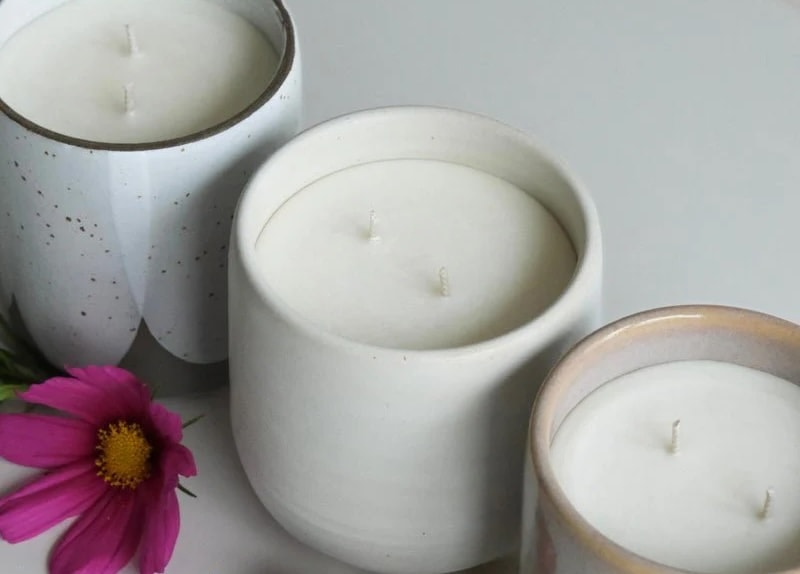
Bienenwachskerzen
Bienenwachs ist ein natürliches Wachs, das von Honigbienen produziert und nur minimal verarbeitet wird – damit gilt es als eines der umweltfreundlichsten Wachse überhaupt. Im Gegensatz zu Sojawachs haben reine Bienenwachskerzen einen natürlichen, honigsüßen Duft, weshalb sie oft keine zusätzlichen Duftstoffe brauchen. Wenn du aber einen intensiveren Duft möchtest, gibt es auch Bienenwachskerzen mit ätherischen Ölen!
Allerdings ist Bienenwachs nicht gleich Bienenwachs – folgende Punkte solltest du beachten:
-
Manche Hersteller bleichen das Wachs oder setzen Zusatzstoffe bei, was unerwünschte Toxine bedeuten kann. Achte daher auf ungebleichtes, 100% reines Bienenwachs!
-
Übermäßige Ernte von Bienenwachs kann Bienenpopulationen belasten. Wähle daher nachhaltig gewonnenes Bienenwachs, um die Bestäubung und den Fortbestand der Bienenvölker zu unterstützen!
Unsere Lieblingsmarken für Bienenwachskerzen:
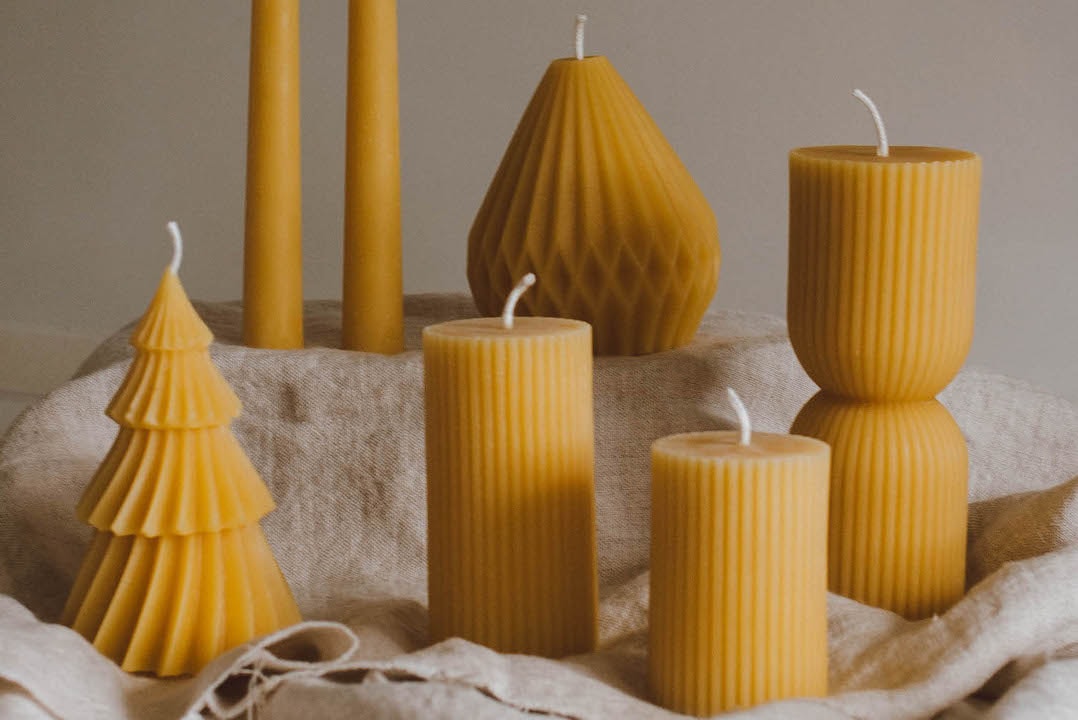
Reinere Luft: Sojawachs vs Bienenwachs
Sojawachskerzen
Sojawachskerzen brennen deutlich sauberer als Paraffin und produzieren weniger Ruß. Dennoch deuten einige Untersuchungen darauf hin, dass selbst 100% Sojawachs noch Spuren von Schadstoffen wie Acrolein und Formaldehydfreisetzen können – besonders wenn synthetische Duftöle verwendet werden.
Diese Substanzen werden mit Gesundheitsrisiken wie Augen- und Atemwegsreizungen, Kopfschmerzen oder Schwindel und einem erhöhten Krebsrisiko in Verbindung gebracht.
Wer ein besonders sauberes abbrennen möchte, sollte also auf 100% Sojawachs mit ätherischen oder phthalatfreien Duftölen achten.
Kerzen aus Bienenwachs
Bienenwachskerzen produzieren kaum Ruß oder Schadstoffe und gelten allgemein als die sicherste Kerzenoption.
Oft liest man, dass sie sogar negative Ionen freisetzen sollen, die sich mit Schadstoffen und Allergenen in der Luft verbinden und sie binden können. Allerdings ist diese Wirkung wissenschaftlich nicht eindeutig belegt.
Trotzdem bieten Bienenwachskerzen nachweislich folgende Vorteile:
-
Nahezu keine Rußentwicklung (Soja dagegen produziert geringe Mengen)
-
Natürliche hypoallergene Eigenschaften
-
Benötigen keine synthetischen Duftstoffe
Weil Bienenwachs komplett natürlich ist und hypoallergen, eignet es sich besonders für Menschen mit Allergien oder Atemwegsbeschwerden!
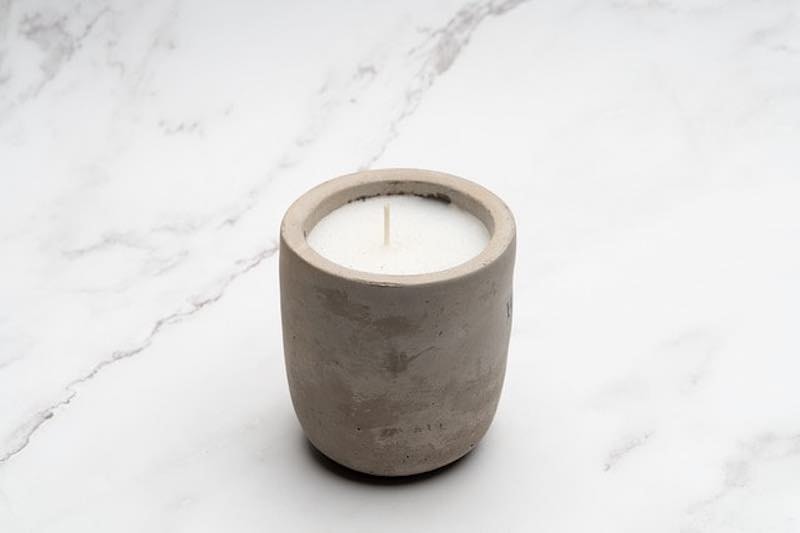
Vorsicht beim Docht: Blei und Schwermetalle
Übrigens hängt es nicht nur vom Wachs ab, wie sauber eine Kerze brennt, sondern auch vom Docht:
-
Sojawachskerzen: Bei manchen günstigeren Kerzen – besonders Paraffin-Soja-Mischungen – kommen Metalldochte zum Einsatz, die Schwermetalle (z.B. Blei) an die Luft abgeben können.
Obwohl solche Dochte in der EU verboten sind, können ältere Kerzen oder Importe das Risiko weiterhin bergen. -
Bienenwachskerzen: Setzen in der Regel auf Baumwoll- oder Holzdochte und gelten somit als sicherere Wahl, weil kein Risiko von Schwermetallfreisetzung besteht.
Achte beim Kerzenkauf daher auf Dochte aus Baumwolle oder Holz, um Schwermetallen aus dem Weg zu gehen.
Welche brennt länger: Soja- vs Bienenwachskerzen?
Wenn du nach Kerzen suchst, die lange halten, ist Bienenwachs der klare Gewinner!
-
Sojawachskerzen brennen zwar langsamer als Paraffin, aber schneller als Bienenwachs. Aufgrund des niedrigeren Schmelzpunkts haben sie eine gute Duftabgabe und sind eine leicht verfügbare Alternative zu Paraffin.
-
Bienenwachskerzen halten am längsten von allen Wachsarten und verbrennen am langsamsten – ideal für maximale Brenndauer!
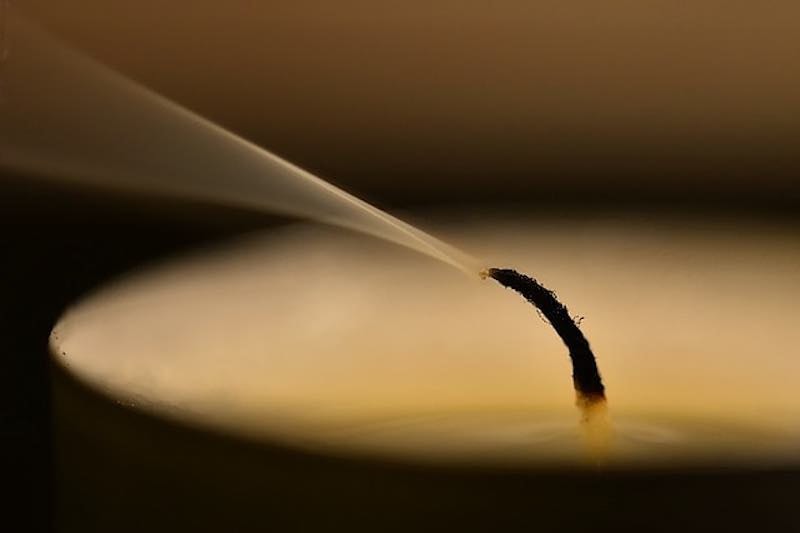
Duftverteilung: Welche Kerze duftet besser?
Die Duftabgabe (wie gut eine Kerze ihren Duft im Raum verbreitet) hängt von der Wachsart und den verwendeten Duftstoffen ab:
-
Sojawachs hat einen niedrigeren Schmelzpunkt, was eine stärkere und gleichmäßigere Duftabgabe ermöglicht. Als natürliches Wachs lässt es sich gut mit ätherischen Ölen oder Duftölen kombinieren und verbreitet so einen gleichmäßigen Geruch, oft intensiver als Bienenwachs.
-
Bienenwachs hat von Natur aus einen milden Honigduft und nimmt zusätzliche Duftstoffe weniger gut auf. Wer also einen kräftigeren Duft bevorzugt, wählt eher Sojawachs.
Wer empfindlich auf Düfte reagiert, sollte am besten geruchsneutrale Kerzen oder reines Bienenwachs verwenden.
Soja vs Bienenwachs Kosten: Was ist günstiger?
-
Sojawachs ist in der Regel günstiger in der Produktion und daher im Handel oft im Bereich von 10-30 Euroerhältlich.
-
Bienenwachs ist aufgrund der begrenzten Verfügbarkeit und aufwendigeren Gewinnung preislich höher angesiedelt (meist 15-70 Euro), bietet aber dafür eine längere Brenndauer und ist besonders umweltfreundlich.
Vergleichstabelle: Soja vs Bienenwachs
|
Faktor |
Sojawachskerzen |
Bienenwachskerzen |
|---|---|---|
|
Brenndauer |
Mittel – brennt langsamer als Paraffin, aber schneller als Bienenwachs |
Herausragend – längste Brenndauer unter den Naturwachsen |
|
Preis |
Kostengünstiger – meist 10-30 € |
Höherpreisig – meist 15-70 € wegen knapperer Verfügbarkeit |
|
Gesundheit |
Geringe Emissionen, kann aber bei synthetischen Düften Spuren von Schadstoffen abgeben |
Minimalste Emissionen – hypoallergen, kaum Ruß, natürlicher Duft |
|
Duftabgabe |
Stärker – niedriger Schmelzpunkt sorgt für bessere Duftverteilung |
Natürlicher Honigduft, weniger geeignet für zusätzliche Duftstoffe |
|
|
|
|
Fazit: Welche Kerze ist besser – Bienenwachs oder Sojawachs?
Die Antwort hängt davon ab, worauf du am meisten Wert legst:
Greif zu Sojawachskerzen, wenn du eine preisgünstigere Kerze mit Duft und guter Duftabgabe möchtest. Achte unbedingt darauf, dass es 100% Sojawachs mit ätherischen oder hochwertigen Duftölen ist. Nachteile könnten sein:
-
Mögliche Zusätze wie synthetische Duftstoffe oder GMOs
-
Kürzere Brenndauer als Bienenwachs
Wähle Bienenwachskerzen, wenn du eine möglichst reine, langlebige und natürliche Lösung möchtest. Achte auf 100% reines, ungebleichtes und nachhaltig geerntetes Bienenwachs. Mögliche Nachteile sind:
-
Begrenzte Duftauswahl
-
Höherer Preis
-
Nachhaltigkeitsaspekte, falls nicht fair beschafft
Beide Optionen haben ihre Stärken, sind aber definitiv eine große Verbesserung gegenüber Paraffin und passen hervorragend in ein schadstofffreies Zuhause. Falls du weitere Empfehlungen suchst, wirf einen Blick auf unseren Guide zu ungiftigen Kerzen mit 13 Top-Marken, die wir getestet haben!
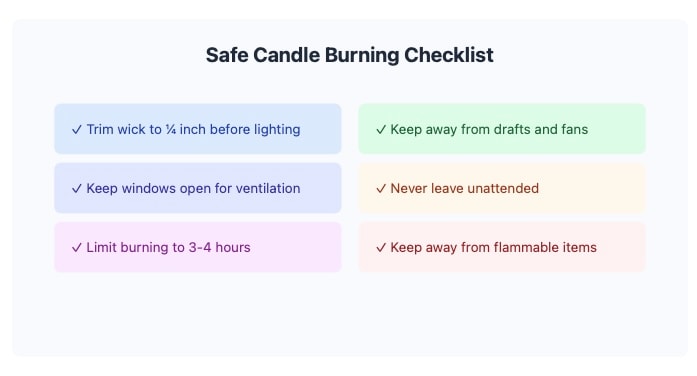
Wichtige Punkte zusammengefasst
-
Bienenwachs brennt am saubersten und längsten! Wenn du eine besonders reine, langlebige Kerze ohne Rußbildung möchtest, ist Bienenwachs die beste Wahl – achte aber darauf, dass es 100% rein & nachhaltig ist!
-
Sojawachs ist preisgünstig und für Duftkerzen ideal! Es brennt sauberer als Paraffin und hat eine bessere Duftabgabe als Bienenwachs, ist günstiger – aber pass auf Zusatzstoffe & Gentechnik auf!
-
Bessere Luftqualität? Bienenwachs! Einige glauben, dass Bienenwachskerzen negative Ionen freisetzen und die Luft reinigen (wissenschaftlich nicht zweifelsfrei belegt). Sojawachs emittiert zwar wenig Schadstoffe, aber mehr als Bienenwachs – vor allem in Verbindung mit synthetischen Duftstoffen.
-
Wichtig: Der Docht! Vermeide Metalldochte, die Schwermetalle an die Luft abgeben. Wähle Baumwoll- oder Holzdochte für einen sauberen Abbrand!
-
Beide Wachsarten sind umweltfreundlich! – Nicht-GMO Soja ist nachhaltig, während ethisch gewonnenes Bienenwachs Imkern und Bienen zugutekommt. Informiere dich gut und entscheide nach deinen Prioritäten!

FAQ
Welches Wachs ist am gesündesten?
Bienenwachs gilt als besonders gesund, da es sauber abbrennt, nur minimal Ruß erzeugt und von Natur aus hypoallergen ist. Es enthält keine schädlichen Zusätze und kann (theoretisch) sogar die Luftqualität verbessern. Sojawachs ist ebenfalls eine gute Alternative, jedoch können beim Mischen mit synthetischen Duftstoffen geringe Schadstoffe entstehen.
Warum ist Bienenwachs besser als Soja?
Bienenwachskerzen sind optimal, wenn dir die längste Brenndauer und ein besonders reines Abbrennen wichtig sind. Sie duften leicht nach Honig und benötigen keine Zusatzstoffe. Sojawachs punktet hingegen durch den günstigeren Preis, eine sehr gute Duftabgabe und ist (bei entsprechender Herkunft) nachhaltig. Die Wahl hängt davon ab, ob dir Gesundheit und Langlebigkeit (Bienenwachs) oder Preis und Duftvielfalt (Soja) wichtiger sind.
Welches ist das gesündeste Kerzenwachs zum Verbrennen?
Als besonders „gesund“ gilt Bienenwachs, weil es natürlich ist, rein abbrennt und (laut mancher Behauptung) negative Ionen freisetzen kann, die Schadstoffe in der Luft binden. Bio-Bienenwachskerzen sind noch besser, da sie frei von Pestiziden sind. Sojawachs ist ebenfalls empfehlenswert, setzt jedoch bei synthetischen Düften minimal Schadstoffe frei.
Was hält länger: Bienenwachs oder Sojawachs?
Bienenwachskerzen halten deutlich länger als Sojawachskerzen, da sie einen höheren Schmelzpunkt und eine dichtere Struktur haben. Ein Beispiel: Eine 100g-Bienenwachskerze brennt etwa 29 Stunden, während eine gleich große Sojawachskerze ca. 18 Stunden schafft. Damit ist Bienenwachs für eine besonders lange Brenndauer ideal.
Welche Nachteile hat Sojawachs?
Sojawachs kann bei höheren Temperaturen leicht weich werden oder sich verziehen, da es einen niedrigeren Schmelzpunkt hat. Es hat zudem oft einen etwas weniger intensiven Duft als Paraffin- oder reine Bienenwachskerzen (wenn man den Honigduft mag). Und: Da die meisten Sojabohnen gentechnisch verändert und stark mit Pestiziden belastet sind, solltest du unbedingt auf Bio- oder Nicht-GMO-Qualität achten.
Was ist das besondere an Kerzen aus Sojawachs?
Kerzen aus Sojawachs sind besonders, weil sie deutlich sauberer als herkömmliche Paraffinkerzen verbrennen und weniger Ruß produzieren, was zu einer besseren Luftqualität in deinen Wohnräumen beiträgt. Sie haben einen niedrigeren Schmelzpunkt, was für eine stärkere und gleichmäßigere Duftabgabe sorgt, und sind zudem aus einer erneuerbaren, biologisch abbaubaren Ressource hergestellt. Achte allerdings auf 100% reine Sojawachskerzen ohne synthetische Duftstoffe, da manche Hersteller Paraffin beimischen oder künstliche Zusätze verwenden.













